The days that followed were dream-like. At times it felt as though we were characters in the Disney animation, Finding Nemo and other times it was like being on the set of Armageddon. Each day we went from seeing the spectacular aquatic beauty of the Galapagos to hiking its shorelines, at times to summits of dormant volcanoes that often looked as though it had spit the worlds underbelly onto its shoreline.
Each day we sailed and dropped anchor in remote and uninhabited coves. We boarded the dinghy several times a day making either wet landings (up to our knees in water) and waded ashore; or dry landings, disembarking on sandy beaches of red, black or white. The material we landed on was sometimes made of sand or pumice and sometimes, lava flows. On a few occasions we simply perused the shoreline and it’s mangroves as was the case in Mangle Point on Fernandina Island.
Here we spent more than an hour quietly motoring along the mangroves watching pelicans return to their nests to feed their young. These enormous birds, with nests precariously built atop the mangroves, were among a community of other nests a wing’s-distance away.
From our panga, we sat and watched while one adult protected the yearlings as the other went off to sea to find food. Upon the adults return, with an open wing span of 2 meters in width, they neatly tucked themselves closely to their young, opened their mouths and one-by-one the yearlings took turns putting their head into, and down the throat of the adult.
The adult then began regurgitating food to feed the youngster who was by now, head-and-eyes into their mouth. This continued for each yearling until all the food was gone. The entire scene was beautifully grotesque!
Later, in Punta Moreno, located on the north coast of Isabela Island, we had our first opportunity to snorkel and OMG! it didn’t disappoint! Here, we swam and observed all sorts of fish, many we had never seen before...but the real treat was watching the sea lions and stingrays swim past us!
Sea lions are a common sight in the Galápagos; they can be observed flopped out on a sandy shore or darting through the ocean with rubberized twists and turns. We never tired of seeing their muzzles popping up near the boat or wandering among them on the beaches. They are utterly charming, albeit wild, creatures and we loved seeing them sunbathe just about everywhere; however, swimming alongside them, at least for a split second, as they whirled about in calm, crystal-clear waters, was an absolute topper-of-an-experience!
Another unique experience was had in Urbina Bay on Isabela Island, where we saw for the first time, land iguanas. Unlike other iguanas we have seen in other parts of the world, here, we had an opportunity to observe their habits. Like a duo of Sherlock Holmes in the Galapagos, we went scouting for telltale signs of presence by looking for trails in the sand left behind by iguana tails. Like looking for rabbit leads in the woods back home, here you could observe low lying shrubby and tell if a land iguana frequents the area.
All animals here in the Galapagos are protected so our observations were strictly scientific though I’d be lying if I said I didn’t wonder what these prehistoric reptiles tasted like!
In Tagus Cove located west of Darwin Volcano on Isabela Island we found a spot where pirates and whalers historically came ashore and following tradition, inscribed the names of their boat on the rock face.
Here we found one ship name dating back to the 1800s that was renowned for visiting the Galapagos to supply their boat with Galapagos Giant Tortoise, an excellent and abundant source of food at the time. Able to survive for a year on water alone, these reptiles were ideal source of fresh food that could be stored in the hull of a boat, maintenance free!
Tagus Cove, also offered amazing views of a salt water lagoon from one vantage point and lava rock at the other which was, simply put, other-worldly. Big knobs of porous rock, sharp and unwelcoming as far as they eye could see. We crawled over the rocks to the summit, careful not to brush the sharp edges; our reward, jaw-dropping scenery and mystical, unearthly pictures!
Not to belabour the point but along the way we found “incense trees” whose sap smelled of incense similar to that burned in churches during special occasions. These trees lay dormant during the dry season in order to survive; both facts that add to the mystery of the island...it was all very Harry-Potter-like!
On the morning of the 4th day we took another panga ride at Espinoza Point, Fernandina Island.
Espinoza Point is known for its large colonies of marine iguanas and has a habitat that’s ripe for housing unique species such as the flightless cormorant, Galapagos penguin, Galapagos hawk, and Galapagos snake, to name a few!
We had been previously introduced to the Galapagos Marine Iguana, described by National Geographic as, not being very pretty, “...with their wide-set eyes, smashed-in faces, spiky dorsal scales, and knotty, salt-encrusted heads. But what these unusual creatures lack in looks they make up for with their amazing and unique ecological adaptations.”
Only found in the Galapagos, these amazing aquatic iguanas eat only algae and seaweed, move mostly at day and cling to rocks to keep warm when they aren’t in the water. This last point was the most fascinating to me.
As we toured the coastline in our trusty panga, our attention was drawn to an iguana gingerly paddling toward a sizeable rock in the middle of the water. It was only when the iguana crawled onto the rock that we noticed the rock, which we previously thought was black in colour (like much of the landscape) was actually a rock peppered with hundreds of marine iguanas. It was fascinating! Unless you took the time to study the rock, one would have never noticed the iguanas and how they blended into their surrounding. All facing in one direction, some piled on top of the next, each one intermittently spitting salt water; this was, hands down, one of the top ten travel pics that will stay etched in my mind’s eye for many years to come! What absolute mysterious beauty there is in this world!
Later, we visited Punta Vicente Roca; located in the north-western coast of the island it is comprised by two distinct islets and boasts spectacular marine life! Here, we swam among dozens of sea turtles, watching them move gently through the water beneath us, popping up every now and again for air! It is quite a surreal experience snorkelling along and finding yourself nose-to-nose with a sea turtle as it surfaces for air.
Looking into one another’s eyes, it’s hard to say whom is more curious about the other. For me, it was certainly a gift sent straight from the heavens!
We were also lucky enough to see a Mola-mola sunfish; a strange and unusual creature in shape and size! There were penguins wobbling about on the rocky shore, a couple of small rays resting on the ocean floor, Terns hugging the cliffs, and Paul’s favourite...Blue Footed Boobies!
Blue Footed Boobies are endemic to the Galapagos and can be seen just about everywhere you look! About the shape and size of a seagull but more reserved in their behaviour, they stand tall on beautiful, pale blue legs and feet that give them their namesake. Paul hasn’t stopped talking about ‘boobies’ since we got here!
Another morning we visited Playa Espumilla, on the northern coast of Santiago Island where we combed the beach looking for the telltale signs of sea turtle nests. With small dugouts found deep into the sand, along the shore where shrub meets the sand-line, there were sure to be sea turtle eggs buried here. With sand piled high in these dugouts, there is a smaller tear-shape mound found at the edge of these remarkable nesting sites. From here leading back to the ocean, like footprints in the sand, are multiple pairs of horizontal lines where a turtle propelled itself toward its watery home after safely storing its eggs. A lot of fuss and work for the lonely sea turtle.
Sullivan Bay, Santiago Island however, was by far, the most shocking experience I had in the Galápagos.
Known locally as San Salvador Island, it is located in the west central part of the Galapagos archipelago. It is the fourth largest island in the archipelago and is also volcanically active. Many young flows and cones, some as new as 250 years old can be seen here and some are even recognizable from space!
For two hours we hiked it’s black beach and headed inland toward the volcano that created it. We could have easily mistaken this place for Mars. I expected at any moment to see extraterrestrial life or at the very least a movie director to jump up from a lava tunnel and shout “Cut!”
In all my travels (and I’ve been to some queer and unusual places) I’ve never seen anywhere like this before and to be honest, I’ll be shocked if I ever see anything comparable to it ever again in my life.
Negotiating my way across this completely unfamiliar terrain, it looked as if hell rained down on earth.
The entire place was a cooled, dark mess. The easier terrain, the lava flows, looked like melted, black plastic bags under our feet and were easier to traverse.
Similarly, layers and streams of wrinkled black rock spread out under us as though tar were poured from the heavens and solidified on its way from the mountains to the sea.
At times the black had hints and patches of bronze in bubbled pockmarks like a plague of adolescent acne on the face of the earth. It was a morose paradox set against the turquoise of the ocean beyond.
Some rocks looked like charred wood after a recent forest fire; there was black pumice and rocks that resembled charcoal and felt equally empty. Some of the crusts have dislodged revealing a sub layer that is bronze and brain-like in appearance. As we walked along, our hiking poles tapping the “earth”, telling tales of subterranean tunnels where ground cooled and gave way. Waiting for the crust to collapse under our feet we watched as the lonesome lava lizard scurried past, stopping to acknowledge the only sign of life he had probably seen, ever.
We stopped to document the carcass of a dead mouse and while we were not certain why he died, we wondered how he ever managed to live in the first place. I wondered, were there others? If so, where were they and how in God’s name are they surviving?
With some desperate signs of life; a poorly looking cactus and the lonesome lizard seeking refuge in the deep dark crevasses of this wretched place, it was like walking through a theme park for a Star Wars movie.
Fantastical and other worldly, we made our way back to the panga. Walking over ribbons of lava twisted like the bands of black twizlers, we were careful with each step.
Looking around us there were cones scattered here and there, waist high, like candles that had been left burning and the wax build up around its base; pitch black.
It was the hike to top all hikes...in a category all on its own...and just when you think this wild and wondrous place had nothing else to offer, we went snorkelling again...
Penguins...there were penguins! Like tiny little bullets shooting about under the surface of the water, they darted past at the speed of lightening! Little bodies whizzing in all directions around you, I nearly spit my snorkel out from laughter. With underwater squeals of delight, I watched as these adorable little creatures zoomed by, hot on the tail of tiny red mullet fish!
At times, the penguins would pop up to the surface to breath and once again I found myself eye to eye with another glorious Galapagos creature! Paul was quick to film the encounter when the penguin turned on him and attacked his GoPro! Howling with delight, we kept a close eye on the critters, who decided to walk across my back before slumbering themselves once again! OMG! I couldn’t believe these wild and wonderful experiences! The Galapagos truly is a magical, mysterious place.
As the sun set behind the Journey Seaman, while manta rays proposed and somersaulted in their ritual mating dance, we enjoyed our final supper together as a group. We said our goodbyes to the crew and thanked them for their wonderful service and each one of us made our way to our cabins in reverent awe of this beautiful place they call the Galapagos.

 Santiago Island, Galápagos Islands, Ecuador
Santiago Island, Galápagos Islands, Ecuador
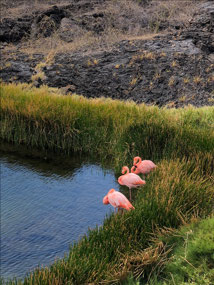
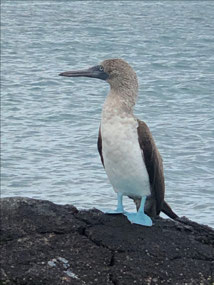
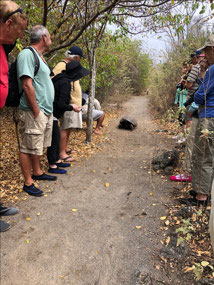
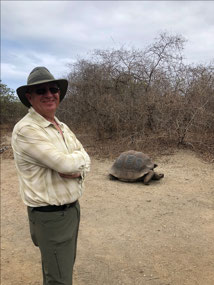
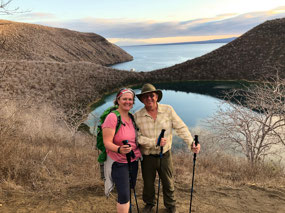
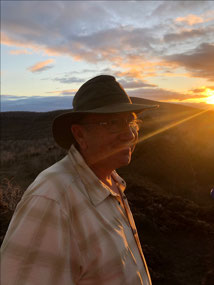
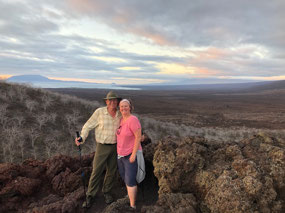





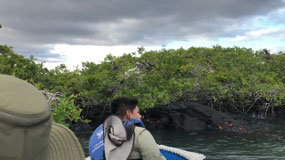
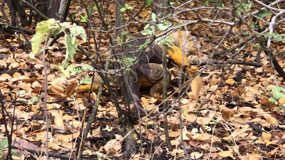
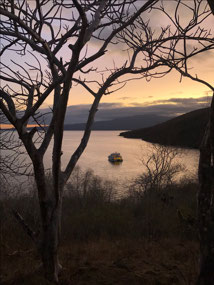
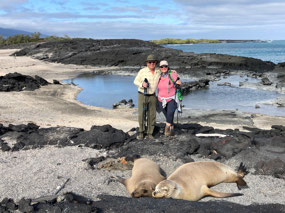
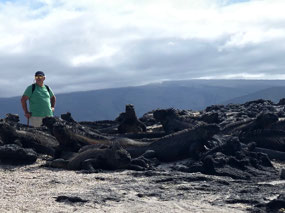
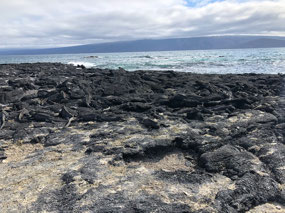
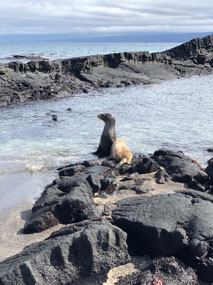

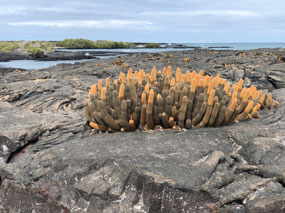
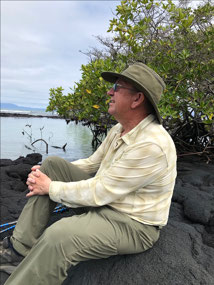
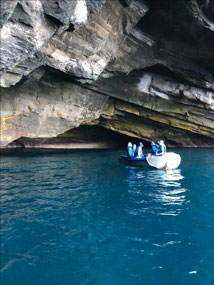

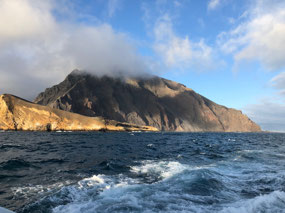

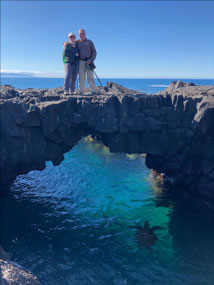
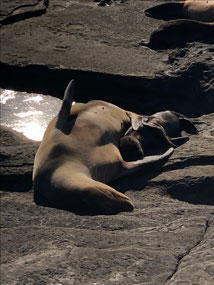
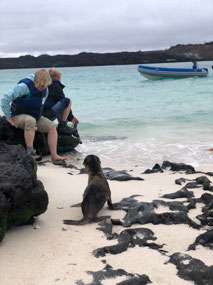
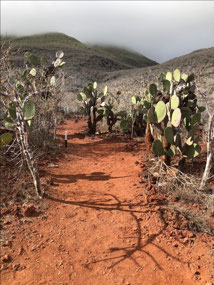

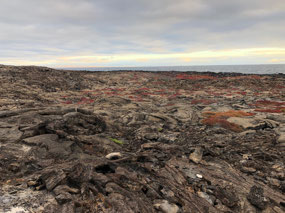
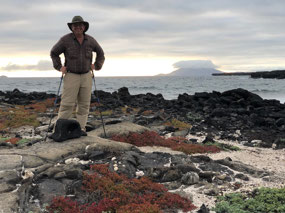
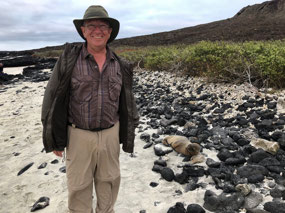
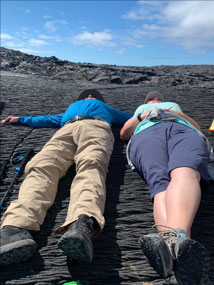
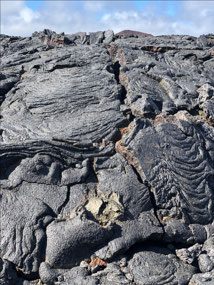
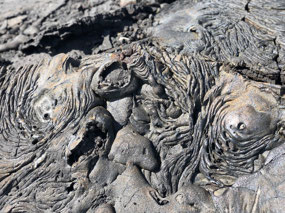
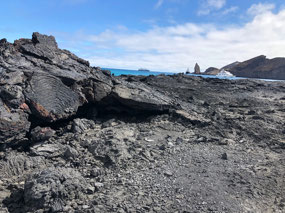
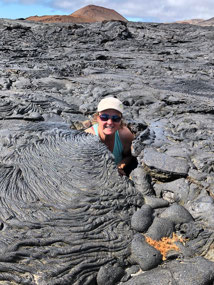
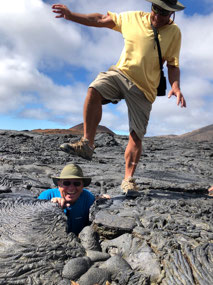
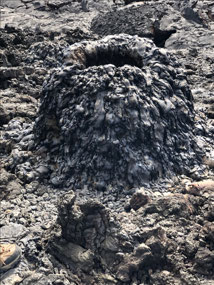
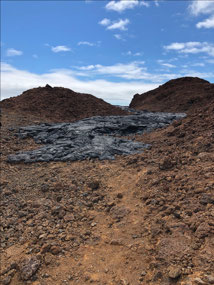
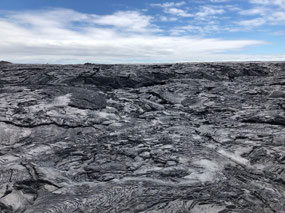
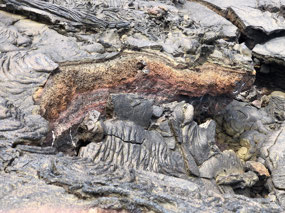
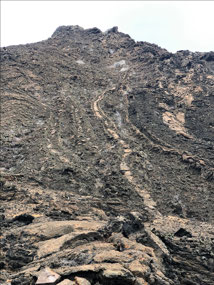
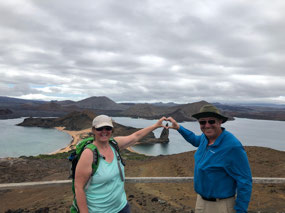

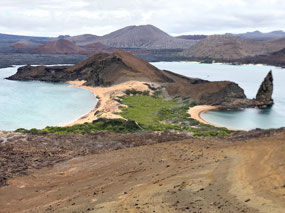
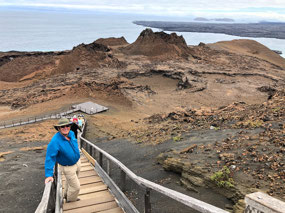
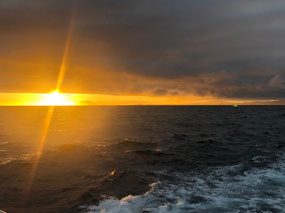

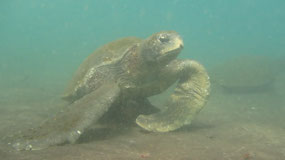
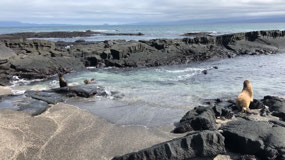
Agnes Penton
2019-11-20
You two were destined for Galapagos. Thanks for the memories - it was incredible. But no account on the type of boat you were on.... Curious!
Jill
2019-11-20
You both look wonderful. There’s no doubt from your pictures that you’re having a wonderful adventure. Enjoy to the fullest. Can’t wait to see where you go next. Safe travels.
Stephanie
2019-11-20
Simply amazing!
Patti
2019-11-20
Wow...such a awesome experience!
Aunt Madeline
2019-11-20
I close my eyes and I'm there with you! Amazing.
Lee Anne
2019-11-20
❤❤❤ I need to go there! Wow!
Daphne
2019-11-21
Amazing pictures, can’t imagine how you must feel being there. Stay safe
Aunt Theresa and Uncle John
2019-11-22
Totally AMAZING! Your descriptive, expressive written language is very image-rich! We see what you see through your descriptive language. We are so close we feel we can touch your descriptions. LOVELY! Keep safe, keep writing! ❤️
Susan
2019-11-23
Loving these latest adventures, you paint a beautiful picture of these incredible places! You guys look so happy!